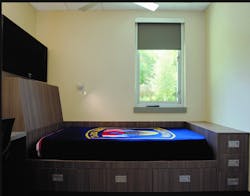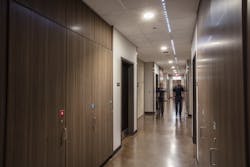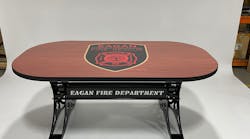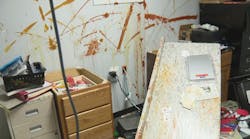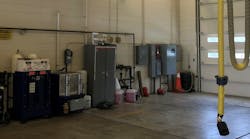After choosing individual sleep rooms or communal bunk rooms, the next decision is how to furnish and equip the space. Furniture selection, millwork design and other elements give departments an opportunity to shape sleeping quarters to fit their specific needs, culture and tastes. Some options give crews more control over their sleep areas, providing better rest to each shift.
Beds
The most logical and obvious place to start is bed selection, by choosing either furniture options or millwork (built-in) options. (Built-in solutions are customized more easily to the department’s needs.) Each choice should accommodate an extra-long twin. Myriad possibilities, from simple bed frames to those that have storage, can serve almost any room size and configuration. Storage under the mattress platform is segmented commonly into thirds, in either three drawers or three sets of doors, to allow one drawer/compartment per shift.
Under-bed storage might raise the mattress platform. Thus, it’s prudent to select storage elements that are congruent with mattress height, keeping in mind that mattresses range between 8–14 inches thick. A high mattress platform that’s paired with a thick mattress can make it an awkward or uncomfortable endeavor for some firefighters to get into and out of bed.
Although it’s impossible to select the favorite mattress for every firefighter who is on shift, there is no shortage of options. This includes foam mattresses, which have become quite affordable over the past few years and are easy to buy online.
When reviewing bed furniture, keep accessibility requirements of the Americans with Disabilities Act (ADA) in mind. This requires a certain percentage of a sleeping area to be accessible. If the accessible room has a single bed, clear floor space on an accessible path is required on each side of the bed. Thus, single-bed sleep rooms in which the bed is placed against a wall don’t comply. If there are two beds, with a shared space that’s between them that meets the clear floor space requirements, the requirement is satisfied.
Wardrobes
Similar to bed furniture, wardrobe lockers can be either furniture or custom millwork. As furniture, wood, polymer and metal options commonly are 22–36 inches wide. The wood and polymer wardrobes typically are simple. Twenty-two-inch versions have a clothes rod across; 36-inch-wide wardrobes have a clothes rod halfway across and cubbies along one side. Metal lockers seemly can include more options, such as built-in seats, lockable compartments and customizable shelf arrangements.
Although a melamine interior is common to the construction of custom millwork wardrobe lockers—and is easy to clean—a high-pressure laminate interior provides more durability and is less prone to chipping and scratching than is melamine. Adding a cubby on the back of the door provides a place for glasses, wallets, etc. Underneath, a hook can be added for a towel. Power is added easily to the wardrobe. Above the wardrobe is a convenient place to add a large cabinet to allow for the storage of linens, blankets and pillows.
Within bunk rooms, frequently, lockers are placed back-to-back. This way, separation between beds is provided.
Millwork wardrobe lockers often have a desk attached to the end, regardless of bunk or individual rooms. These desks typically are simple work surfaces. In bunk rooms, desks might be included, but, typically, not one for every bed.
Alerting systems, etc.
The complexity and functionality of station alerting systems vary. On the simpler side, rooms are equipped with a tone-out speaker and a dedicated light that has an amber light or lens. More-sophisticated alerting systems have remote controls in each room, so occupants can select their assigned apparatus, to only receive calls when necessary. These systems usually include speakers and built-in LED lights.
An adjustable reading light that’s mounted to a wall or headboard allows the user to read or surf the internet in bed without the need to get out of bed to turn off the lights when retiring. In a bunk room setting, the reading light can be used to get ready without turning on overhead lights, which could disturb others.
For additional control, a second set of switches can be added at the bed to adjust the overhead light and fan. The ceiling fan switch should have speed control and be hardwired. One might find that remote controls that serve as replacements for hardwired controls can be a maintenance headache—and be prone to be lost.
An advantage of sleep rooms is the acoustical privacy that they offer and all of the associated benefits compared with bunk rooms. Nevertheless, for building code reasons, the walls that are around sleep rooms likely go to deck, so the noise from a firefighter who snores still can pierce walls. Similarly, the move to hard flooring in firehouses for cleanability makes voices and footsteps echo down hallways.
To mitigate sound transfer that can occur between sleep rooms or bunk rooms in the firehouse, you can consider the use of six-inch stud partitions that are full of sound-attenuation blankets as the first step in the effort. To reduce sound transference between sleep rooms or bunk rooms, an additional layer of gypsum board can be considered for placement on one or both sides of a wall that divides rooms.
Another approach to reduce sound transference is to stagger 3-5/8-inch metal studs within the six-inch track of the wall.
To limit sound through the door, smoke or acoustical seams can be installed in the frame, and a drop-down acoustical seal can be considered for installation on the door leaf.
Black-out shades are a must in sleep and bunk rooms to achieve the level of darkness that many firefighters prefer. The shades’ side and sill channels keep most of the light out; an optional vinyl edge on the shade hem further aids in the effort. If the shade is installed in front of an operable window, you must ensure that the means of opening the window doesn’t conflict with the shade. In lieu of a hand crank, cam locks are a solid option.
More control, more satisfaction
Sleep rooms and bunk rooms give opportunities to provide amenities or correct configurations that departments might not like in their existing stations. Moreover, firefighters are afforded more control of their spaces, which promotes work satisfaction among them.
